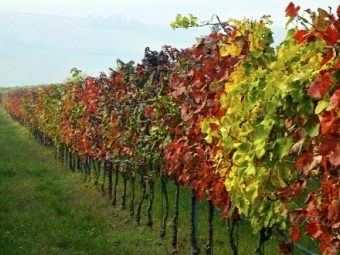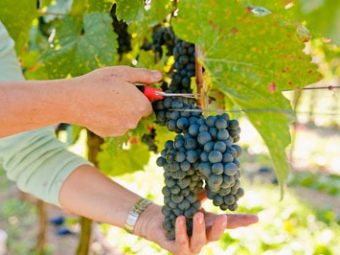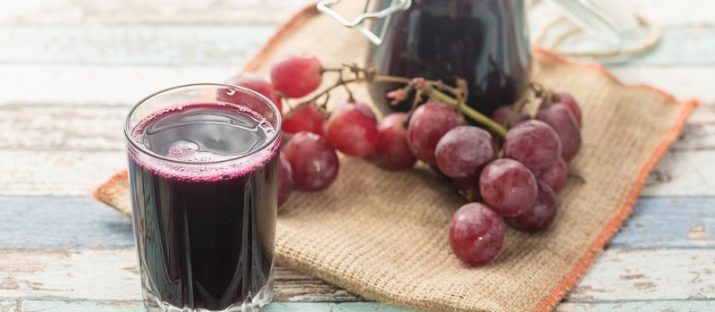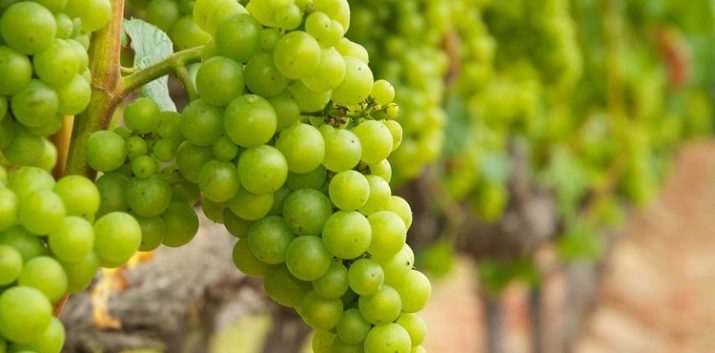All about grapes: what happens, what is useful and where is it used?
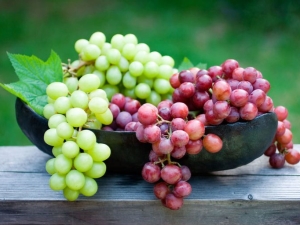
Grapes are highly valued by farmers and gourmets since ancient times.But even a seemingly well-known culture when used has many subtleties and nuances that must be taken into account. Experienced gardeners do not get down to business, not figuring out all the botanical specifics and features of care for a particular variety.
Description
Since ancient times, grapes had a huge role in agriculture and trade, in navigation and the development of individual crops. He is mentioned in mythology and folklore, which is not awarded to every agricultural or wild plant.
Receiving wine and vinegar from it for several millennia has been consistently supported in several regions of the world. But the ideas of most people about this plant are rather weak, and sometimes far from reality. Because it is important to understand what it really is.
Botanical features
Biology classifies all cultivated grapes as Vitis Vinifera. Yes, this is exactly one genus, despite all the existing differences. There is nothing surprising in this, because the difference between dogs or cats, for example, is even more pronounced, and this is not a kind, but only a species. The common answer is that a grape wine is a berry is fundamentally wrong, in fact it is a fruit. Wild thickets of culture are found in the Mediterranean forests, where the grapes grow as a shrub of a perennial cycle, giving abundant long vines.
Rising by attaching to the branches of tall trees, the vines reach a great height. In gardens and on plantations, this is specially fought using annual pruning. Vine attached to the stakes or to the trellis. The roots, along with the stem, form an underground lobe of the bush. The roots branch out from the heel and from the trunk nodes, then the second branching stage occurs, already on the entraining nutrients of the roots. The optimal root system is characterized by the heightened development of heel roots, climbing deep into the ground. They will help support the plant during dry periods and will survive even in severe frosts.
The height of the boles is determined by how the plant is formed. On the territory of the Volga region and in other places where sheltered bushes are bent to the soil, the above-ground part of the trunk may not exist at all. The so-called “shoulders,” or otherwise, “sleeves,” are branches that have been growing for many years, which persist and reach a length in excess of 0.4 m.
There are also shortened “sleeves” that are artificially formed by trimming up to 350 mm or even less. The main fruits are obtained from annual shoots, cut at least 8 eyes, these are the so-called fruit vines (straight "arrows" and curved "arcs"). The buds remaining during pruning during the growing season are able to form annual shoots of 200-400 cm in length. Growth shoots coming from the "sleeves" or trunk, in the initial season are useless, but in the next year they will receive the optimum yield. Foliage growing on the nodes of annual shoots, has five blades or is whole, growing on elongated cuttings.
The pubescence of the leaf varies for each variety. Paceniks are formed from the axils of the leaves, and the lower buds of the stepsons are able to overwinter. Vegetative shoots have tendrils clinging to a tree, to a fence or other support provided purposefully. Grapes differ from other fruit crops in their complex arrangement of buds, in which, along with the central part, there are 2 or 3 replacement buds, which are overgrown with common scales outside. The development of lateral buds occurs only when the middle part dies; this is a kind of biological substitution.
Fruit shoots of grapes almost always form from 1 to 3 inflorescences, only occasionally they are more. The inflorescence itself is classified as a panicle with axes of three orders of magnitude; short pedicels are capable of forming flowers of 0.2-0.4 cm in size. Five flowers with five leaves and five leaves, five leaves and five stamens are formed on the grapes.The agronomic value of grapes directly depends on the type of fruit elements in a flower. Hermaphroditic varieties are considered to be self-fertile and therefore suitable for growing on their own.
Functionally, female varieties cannot fertilize themselves, but the male ones, although they develop the ovary, cannot produce a crop. Nevertheless, these two subspecies, despite their economic insignificance, can give huge benefits in obtaining hybrids. Grape clusters reproduce the same structure that inflorescences have. Each cluster is conditionally divided into:
- crest;
- peduncle;
- berries.
The type of branching of the ridges and how strongly it occurs determines the density of the clusters. Small clusters - up to 130 mm, and large - over 180 mm in length. Botanists are divided clusters and geometry:
- in the form of a cone;
- in the form of a cylinder;
- branchy view;
- winged appearance;
- some other formats.
Fruits can also differ in different configurations - some closer to the circle, others - to the oval, there are flattened and egg-like. In addition to the green and black colors, the berries can have pink, gray and purple.
In most cases, the skin is covered with a waxy coating. Usually the berry has from 1 to 4 seeds. There are single varieties that do not contain bones.
The upper part of the grape shoots, curving downwards is evolutionarily designed, like other lianas, to bypass obstacles. Attaching the tendrils to the branches is considered one of the most durable types of plant ties. Since the shoots grow with the so-called vertical polarization, only those buds that are at the very top grow effectively. If the grapes grow in pronounced shade, the green mass grows (the shoot stretches), but the foliage is soon lost. The ease of the stems remaining on the surface is achieved by saturating the intercellular space with air when the cell membranes are in a plug state.
Root stem formation is very active, so the culture is diluted with cuttings and cuttings, as well as the grafting method. Usually, the better the grapes are protected from frost, the less actively it takes root.
Propagation by seeds is advisable when preparing new varieties. For ordinary gardeners, seeds are interesting only as a way to get stock, not infected with viruses. The quality of root systems is largely determined by the soil.
If the main nutrients and water are concentrated in the surface layer, the roots go there and rush. For grapes growing on fertile black soil, the descent of roots is deeper than 0.6-0.7 m. When the soil mass is made of sand, they reach 1.2 and sometimes 1.6 m. and it is poorly irrigated, individual roots are able to descend by 15-18 m. The further south, the deeper they get. The discrepancy in width can reach 8 m, occasionally there are also long distances.
The root system of grapes produced in North America is thinner than that of varieties of Eurasian origin. But in the second the root thickness is greater, the fibrum is reduced. Interestingly, the roots of grapes sometimes grow even in the winter months. Of course, young branches do not appear, but those that already exist mature and are covered with cork bark outside. The fragility of the nourishing hairs and their death in the cold season of the year is compensated by a quick update.
The best conditions for the development of roots are formed when the air temperature is from 20 to 30 degrees, while the soil should have a humidity in the corridor from 70 to 80%. Waterlogging and oxygen deficiency adversely affect their condition. Therefore, loosening the soil when they are too dense or immediately after watering is recommended in all climatic zones. As for the stem, during the growing season it is formed by a cascade of green shoots covered with leaves. When the leaves fall and there comes a period of rest, the shoots turn into annual vines.
The emergence of leaves on the shoot occurs in all nodes with opposite alternation. Petioles can move leaf blades so that they are at right angles to the light flux. If the level of insolation is insufficient, the scape becomes very long, and the development of the leaf blade stops.
To stems normally developed, requires a significant amount of nitrogen. The life of the grape stem can last more than 20 years.
Varieties
Acquaintance with the botanical description of grapes can even cause some bewilderment: how such a diverse culture and manifestations exist. In fact, everything is simple - the case is only in the presence of different varieties. Spontaneous, and from a certain point conscious selection inevitably yields its results. The total number of cultivated varieties and hybrids of grapes in the XXI century exceeded 20,000.
The Eurasian group of varieties is characterized by low resistance to cold, easily damaged by phylloxera and fungi. But such plants give a tasty harvest. It is customary to divide this group into four smaller communities. The Eastern Conglomerate originates from Central Asia, the Transcaucasian countries and the Middle Eastern region. Predictable features of it are:
- the need for a long period of growth;
- resistance to dry periods;
- weak protection from hypothermia;
- active growth.
Fruits are juicy, slightly crunch when eaten, clusters develop powerfully. This grouping includes a number of first-class table varieties, but there are also subtypes suitable for the production of raisins. On the territory of the Russian Federation is widely used varietal group of the Black Sea basin. It forms bushes of moderate height with significant formation of fruitful shoots, it requires only a short period of vegetation. Naturally (compared to the Eastern conglomerate), a positive shift in resistance to cold and a negative shift in drought resistance.
The attention of gardeners is riveted on the Western European grape community. It is also represented by bushes of average height, and it looks like the Russian formation is still an active way out of fruiting shoots. It takes a long day of light, but the growing season may be limited. Cold resistance is pretty decent, the purpose of use is exclusively processing for wine. North African grapes tolerate dry spaces very well, but frost is fatal for it.
The East Asian line is almost 40 species, their knowledge is assessed as weak, and therefore botanists cannot give serious recommendations for breeding.
The focus is on Amur grapes:
- North (from the Khabarovsk Territory);
- Chinese (grows in the southern areas of China);
- southern (area of development - the latitudinal belt of Vladivostok).
Wild Amur grapes form highly developed lianas that grow up to 25 m, while the stem diameter is large, as is the length of internodes. On the bushes only small clusters with small-caliber berries are formed. When autumn comes, the foliage turns purple or even red; grapes tolerates frost, requires a lot of water and almost not subject to pathology. There are 28 grape species in North America, but there are only four that have cultural significance:
- Vitis rupestris;
- Vitis berlandieri;
- Vitis riparia;
- Vitis labrusca.
They create powerfully developed lianas of small size, or shrubs creeping along the ground. North American grapes tolerate cooling well and are distinguished by decent immunity to major grape pathologies, including phylloxera.
The clusters are small, the berries, too, are painted black, but there is also a white and pink color. These characteristics allow the use of North American varieties for the formation of stable rootstocks and selection.
The classification according to taste means the selection of such groups:
- ordinary;
- solanaceous;
- nutmeg;
- isabella variety.
Standard taste is simply a combination of sour and sweet sensations, which have different proportions, but do not contain other flavors. Isabel view more like pineapple, strawberry or black currant. In most cases, this taste is characteristic of berries of American origin. Even a general acquaintance with grapes and its varietal diversity shows that producing countries also have to be very different, and this assumption is confirmed. Wine varieties of this crop, for example, are actively grown in Algeria and Argentina, in France, Spain, and Italy.
Gardeners generally try to cultivate table varieties. They allow you to get a beautiful and tasty harvest, used mostly without additional processing, the collected berries are easy to transport. Variety "Arcadia" is able to give bunches up to 2 kg, tolerates frost well and practically does not get sick. It is recommended to ration inflorescences and promptly make dressing. Watering is done carefully.
"Delight" ripens very early and gives great fruits that have a delicate nutmeg aftertaste. Variety immunity will satisfy almost all farmers. But it does not help protect against phylloxera. If you leave ripe berries on the branches up to 45 days, they will not become worse. Quite good results are given even by the “White Kishmish” grown from antiquity, belonging to the dessert group.
But the problem is that the fruits of this sort, with all its sweetness, are also different softness. Long-term storage or long-distance transportation is almost impossible. It is necessary either to use them fresh, or to process the whole crop into raisins. Another disadvantage of the White Rumor is the high susceptibility to pathologies and harmful insects. Do not do without pruning.
Composition and properties
Grapes - not just a tasty fruit, it is also good for the body. Chemical analysis showed the presence in the composition of the fruit:
- antioxidants;
- enzymes;
- fiber;
- vitamins;
- trace elements;
- pectin.
It is noted that under the action of grape enzymes, the production of gastric juice will be enhanced, and iodine makes the body temperature stable. Improves the effect of the heart and blood vessels, lowers blood pressure, accelerates the release of blood from harmful substances. The use of cellulose for digestion has been known for several decades, and even medicine, which is constantly revising its approaches, treats it favorably. The grape fruit contains vitamins K, A, C, P, E, as well as the biological precursor of carotene.
The grapes are not strong, but weak, so the evacuation of harmful substances from the digestive tract is simplified. It is recommended, though with caution, to use it to recover from food poisoning. The berries are not too nutritious, for 1 kg there are 720 Kcal, which makes them acceptable for those on a diet. Vitamin B has a great effect on the state of the nervous system. Due to flavonoids, memory and a number of other brain functions are improved.
Antioxidant pterostilbene promotes the breakdown of low density cholesterol and blocks the destruction of cells. Thanks to amino acids, hormones and metabolism are optimized. The presence of resvetarol is beneficial in that it interferes with the development of malignant neoplasms and has a number of other effects that have a positive effect on life expectancy. Acids of the phenolic series clear the bloodstream, and quercetin, along with the elimination of edema, suppresses spasms.
Eating dark grapes helps:
- reduce the risk of Alzheimer's disease;
- suppress depression and stress;
- stop pathological changes in the respiratory system;
- fight gout
The red type of grapes is more effective than black quenching cell regeneration.Green berries help to strengthen blood vessels, including capillaries, reduce the likelihood of thrombosis, a wide range of infections and leukemia. Their usefulness in the prevention of oncology is noted, although not as large as that of the red counterparts. The active saturation of the lungs with moisture reduces the severity of asthma attacks and their frequency. Much depends on what specific part of the plant is used.
A decoction of raisins with the addition of onion juice helps get rid of cough. It is also useful for constipation and anemia. Ash produced by burning the vine suppresses the development of hemorrhoids and nervous exhaustion.
Water infusion of this ash accelerates recovery after bruises, and if you add olive oil to it, the joints will strengthen and the healing of broken muscles will be easier. Broths and leaf infusions fight against skin diseases, sore throat and periodontal disorders, dysentery, and suppress vomiting.
Possible harm
The presence of glucose makes grapes potentially dangerous for patients with diabetes mellitus of both types and having a predisposition to it. It is unacceptable to its excessive consumption by people in whom the metabolism is distorted or pancreatic dysfunction is detected. Dark fruit varieties can adversely affect dental health if you get too carried away with it. Grapes of this color are not recommended to anyone who suffers from allergies, from stomach ulcers or from a decrease in hemoglobin.
Red varieties, due to the presence of polyphenols and tannins, can cause migraines. Strictly avoided they need patients with diabetes and various allergies. Harmful effects can occur with increased acidity of the gastric juice and in violation of the bowels. After all, the laxative effect significantly increases the load on these organs.
Patients with hypertension should not get involved in grapes, because when eating large portions of its positive effect is quickly suppressed by excessive accumulation of fluid in the body.
Nuances of use
It is important to take into account that there is no abstract benefit or harm from the grapes; a great deal depends on the personal characteristics of those who use it. What is safe for adults can be extremely unpleasant for children. Having tasted sweet and juicy grapes, they naturally will be to this fruit. But the higher the responsibility of adults who must make an informed decision - when can you give grapes. An equally important question is related to the size of the portions.
It should be noted that this fruit helps to increase weight gain, increase appetite and speed recovery from illness. But when kids are prone to completeness, metabolic disorders or have abnormalities of the excretory, cardiovascular systems, it is worth giving only a symbolic portion. When making the diagnosis of "obesity" or "diabetes mellitus" no grapes, regardless of the age of the child, should not be in the diet! Even completely healthy children are encouraged to give grapes only in between meals. It is completely unacceptable for 1-1.5 hours before going to bed.
Doctors advise first to try red or green grapes. Dark varieties are much more likely to cause allergic reactions.
Even adolescents should better avoid large portions of fruit, because it promotes fermentation and the formation of gases. For the same reason, it is necessary to “dilute” it by the time of its use with milk, dairy products, fatty foods, onions, garlic and soda water.
Organic acids affect children's teeth even worse than the teeth of adults. Therefore, until the enamel is mature, it is necessary to feed the children with grapes with great care. Some of the children not only poorly digest the grapes, but may also encounter liquid stools. This is all strictly individual, and a similar effect cannot be predicted in advance.Therefore, all the consequences within 12-24 hours after the first portion of berries in life should be observed carefully.
Summarizing all the above, we can conclude: the first “acquaintance” with juicy fruits can be made at least in 2 years. Most pediatricians are advised to play it safe, postponing this moment to 3 years. Then the likelihood of bad health effects will decrease dramatically. This refers to the grapes "in pure form"; But to enter it into dishes that have undergone heat treatment, it is possible already from 1.5 years. At about the same time, it is allowed to sample juices and compotes (but only in the complete absence of allergic reactions).
Of great importance is the way the berries are served. At least 4 years old, you should refrain from consuming the skin and bones. The very first test is to check the reaction of the child to a single fetus. If tolerance is decent and no health effects are noticed, the dosage rises systematically (up to a maximum of 0.1 kg in 24 hours). Even such portions can be consumed only 8-12 times per month. As for the seeds, eating them in insignificant amounts (the key word is “insignificant”), the child will not suffer at all.
Grape compote contains less ascorbic acid than fresh fruit. But the concentration of trace elements, vitamins B and antioxidants does not change. But the destruction of fruit acids only positively affects the state of health. And even adults should not ignore this recommendation, it is also useful for them to prefer compote to fresh grapes. The sweetness of the product allows you to do without additional sugar.
Of course, before cooking the grapes must be thoroughly washed. And even a ready-made relatively safe product is given to children, first of all, at 30-60 g. Only with success, they systematically increase their use, carefully monitoring the result.
A similar approach will help enter into the diet and juice. The first test is carried out in the amount of only a few drops, and they are diluted with warm water.
Grape juices of both factory and home production can be put on the children's table no more than 1 time in 3-4 days. To reduce the danger to the teeth can be due to the use of the tube. It is recommended to use for the baby food only the grapes that are grown personally. Of the varieties purchased, light-colored kishmish is best, which is not only safe (due to the lack of seeds), but rarely causes allergic reactions.
In any case, do not give unripe berries, as well as those that:
- showered with shaking;
- scratched;
- got moldy;
- have rotten patches.
It so happens that with all precautions all the same, an allergy develops. For a start, it is important to understand what the body reacts to. When using dark varieties, the first “suspect” is the pigment. But besides him, the source of an unusual reaction in adults and children may be the yeast on the skin and the reagents used for pest control, as well as preservatives. Allergies are generally expressed locally, in the digestive system. Less commonly, it affects the skin and breathing complications are very rare.
Regardless of what symptoms are manifested and how they are expressed, you should immediately stop eating grapes and consult a doctor. Even at the end of a full course of drug therapy, children should be given berries again after at least 2 or 3 months. Another important issue that worries a large number of people is whether a nursing mom can eat grapes, is it not a threat when breastfeeding. The main danger in this case is the same allergic reaction, which is particularly likely to occur in the first months of life. Another threat is dysbiosis and bowel failure.
You can reduce the danger if:
- thoroughly wash the berries before eating;
- start with taking 50% diluted juice;
- drink juice in the morning before meals, and 1-2 days to monitor the well-being of the newborn;
- in the absence of allergy, introduce fruits gradually, and if there is one, do the second approach in no less than 60 days;
- take the berries only after 2 or 3 painless receptions of juice;
- limit daily consumption to 100 g, and weekly - to 200 g
A very topical issue is the effect of grapes on weight loss, on the effectiveness of various diets. There is a stereotype that this fruit contains an excessive amount of sugar, which increases the caloric content of food. In fact, you only need to carefully calculate the portion for each day and take into account compatibility with other products. Grapes contribute to saturation and suppresses the feeling of hunger. Improving mood also helps reduce the negative effects of diet.
Cell aging slows down, skin condition improves. Increase the effectiveness of rehabilitation for adults can eat berries along with the skin, because it contains the main share of vitamins. Before using the grape diet or eating grapes in other diets, you need to thoroughly check if there are any contraindications.
It must be remembered that with prolonged consumption of the fruit, excessive saturation of the body with vitamins is possible. It is unacceptable to eat unripe fruits, each of them may contain toxins.
Monotonous grape diet can not be applied for more than 3 days in a row without a break, otherwise harm to health is likely. Nutritional value of the fruit is not significant for those on this diet, it does not have time to affect in a short time. Such a diet requires drinking more than 2 liters of water per day to remove hazardous substances. A gentle version of the grape diet can be applied for about 4 days.
In addition to grapes, this diet involves eating:
- chicken breasts;
- potato dishes;
- fish;
- pumpkins;
- sour cream and forest mushrooms.
Application
Grapes perfectly helps not only in standard and dietary food, but also in cosmetic procedures. More precisely, grape vinegar is used for this work. It contains a lot of antioxidants, as well as vitamin P, which is able to rejuvenate cells, prolong their life. Vinegar activates the metabolism, it also:
- whitens the skin;
- suppresses the smell of sweat;
- suitable as a wrap for losing weight;
- strengthens hair, gives them a silky shine;
- removes poorly water soluble cosmetics.
In addition to face masks, wine vinegar can be used to combat digestive disorders, metabolic disorders, reduced appetite and pathological fatigue. But do not use grape vinegar for young children and minors, as well as nursing mothers.
It has a bad effect on people who have a bad heart, vessels, intestines and gall bladder. It is unacceptable to rinse the mouth cavity with acetic solution, otherwise the tooth enamel will be destroyed. Make this useful product you can do it yourself at no extra cost.
For work you will need 1 kg of fresh fruit, sugar and chilled boiling water. First make pulp, that is, crushed grapes. Clean raw materials are undesirable because positive microbes gathering on the surface increase fermentation. The pulp is transferred to the glass tank, it can be filled to ½ volume. Attention: it is better to take containers with a wide neck, it is more convenient to use them.
The pulp is diluted with water (1 l), 100 g of sugar is mixed with the solution. The mouth is washed outside with gauze, the workpiece is kept in the dark and warm for 14 days. Periodically, the liquid is interfered with a wooden spatula. The more oxygen will penetrate into the mass, the more efficient the production of vinegar. When the exposure time is over, the squeeze is supposed to be squeezed through gauze. Braga is filtered through the same gauze or through a sieve with a small cell.
Next, add about 100 g of sugar to the prepared liquid, mix it, and re-wrap gauze. Defend the capacity of the second time about 60 days. If the process goes faster, it is retrieved earlier. Willingness is assessed by fluid clarification. Cooked vinegar should be filtered and poured into bottles. Hair care is possible using equally light or dark vinegar.
The positive effect is ensured by the presence of vitamins A, C in it. They make the curls less brittle and reduce their loss. No less useful are organic acids, which do not just nourish the hair, they also reduce the itch that overcomes many people. In combination with trace elements, vitamins will help strengthen the hair follicles. A positive effect with proper use of vinegar has on the skin.
Thus, the presence of calcium in it reduces the risk of epidermis coarsening, reduces the risk of corns and calluses. Hands and feet can be treated without dilution. But on the face should be applied only a small amount of the active substance, and always diluting. Wine peeling begins with soaking gauze with a slightly warm liquid and lining it on the face for ¼ hours. Then an hour simply dries the skin, as a result, it will become more vigorous and less tired, get rid of the out-of-date layer, acquire a smooth and youthful healthy shade.
With all the positive effects of this method of cleaning the skin should not be abused. The recommended frequency is 1 time for 30 days or even less. 60 g of grape pulp in a mixture of 30 g of ground coffee and 30 ml of lemon juice make it possible to make a very good hand mask. The mixture should be rubbed into the skin for 5 to 7 minutes. After holding for 10 minutes, it is necessary to wash off the used substance. As a result of treatment fine wrinkles are eliminated.
Dish recipes
Even more than in cosmetology, the importance of grapes in the culinary business. A vivid confirmation of this is the deserved popularity of grape syrup. On an industrial scale, it should be obtained from fresh juice that has been pasteurized or frozen. But some manufacturers simply bring the unusable product actually to the standard through additional additives of dubious quality.
A well-prepared syrup should not be sediment. He is also supposed to be transparent, with an exaggerated sweet taste (an acidic shade is allowed).
Be sure to maintain the original taste and color. The nutritional value is determined by the amount of sugar input. To independently prepare a syrup, take white grape varieties:
- chardonnay;
- nutmeg;
- rkatsiteli.
It is possible to use black varieties, but then you get a saturated dark liquid. After mixing the juice obtained with any available method with sugar, it is heated. If you want to get a thick product, you need to boil the mixture. Storage is allowed only in the refrigerator. An attractive solution in some cases is pickled grapes.
For the preparation of the marinade you will need 0.1 kg of sugar and the same vinegar with a concentration of 9%, which is dissolved in 1 kg of water. The mixture is cooked strictly for 5 minutes. Marinating is best carried out in large containers, then large clusters will fit in them, and the result will be very beautiful. Before canning grapes thoroughly washed, because any dirt can spoil the procedure. Filling with hot marinade is preceded by adding bay leaves and cloves.
Sterilization of the jar is 12 minutes, after rolling it wrapped for 6 hours. Adding marinated grapes to salads is not the only possibility; it can also serve as a good alternative to prunes. Armenian traditional marnovani recipe has significant differences. So, it is recommended to take vinegar 2 times more, and sugar - 2 times less.In addition, 50 g of honey, 20 g of table salt, 5 g of cardamom and 5 carnations are added; Can sterilization is exactly 20 minutes.
Another useful product that is easy to make from grapes is seedless jam. It is recommended to use white varieties that contain more natural sugar. Also, a good result gives the use of a black "Isabella." For 1 kg of grapes you need to use 0.5 liters of water and 1 kg of sugar, as well as 15 g of citric acid. Be sure to wash each berry on a branch, then they are carefully removed and spread in a deep bowl, in which it is washed again with cold water.
If the grapes themselves have stones, they can be carefully removed with needles or pins.
The next step is cooking syrup. In an enamel saucepan, boil the required volume of water, pour in the sugar and boil until dissolved. Immediately after that, you need to pour out the grapes, switch the stove to the minimum heating mode and cook the liquid for 40 to 60 minutes until it thickens. At the same time used components are mixed from time to time. Only in the last minute is to introduce citric acid.
Extracted from the grape seed to throw away optional, they can become a source of vegetable oil, going to salads and other cold snacks. With the help of the same butter, fried and baked dishes are prepared, and, judging by the reviews, they really have an extraordinary taste. Grape leaves are a pleasant component of a variety of salads. Young foliage is absolutely necessary in the process of working on dolma. Cupcakes and biscuits stuffed with raisins are not the first century, they are the favorite filling of any holiday table.
Regardless of which particular dish with grape leaves will be prepared, they need to be boiled for a few minutes in hot water. Often such a component is included in fish dishes, where it helps to muffle the flavor that is not liked by everyone. To prepare the sheet for winter dolma:
- wash it under the tap;
- steamed in boiling water;
- dried;
- placed in a kind of "envelopes" of 5 pieces;
- lay out these blanks for sterilized banks;
- close the remaining volume with hot brine;
- clogged banks lids.
In the next video you will find a simple recipe dolma from grape leaves.




